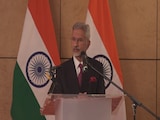- Sindoor khela on Dashami marks a ritual of marital bliss and feminine power in Kolkata.
- Women wear traditional sarees showcasing cultural heritage during Dashami celebrations.
- Visarjan processions immerse Durga idols in the Hooghly river amid drums and chants.
Kolkata during Durga Puja is an experience like no other, but it is on Dashami - the final day of the celebrations - that the city truly shows its heart. Known as Bijoya Dashami, the day is both an ending and a beginning, when devotion meets festivity, and goodbyes are layered with promises of return. From the colour of sindoor khela and the grandeur of immersion processions to the feasts, sarees, and emotional farewells, Dashami turns Kolkata into a living stage. It is here that tradition, community, and artistry unite, making Dashami one of India's most unmissable cultural moments.
Also Read: Navratri 2025 In India: 7 Best Places To Celebrate, What To Pack And Travel Tips
Here are 8 reasons why Dashami in Kolkata is unmissable:
1. Sindoor Khela: Vermillion Rituals That Define Dashami
The day begins with one of Dashami's most iconic moments - sindoor khela. Married women gather to smear vermillion on the goddess and then on each other. Dressed in the traditional laal paar shada saree, they laugh, cry, and embrace in a ritual that symbolises marital bliss, fertility, and feminine power.
"It is the most Instagrammed moment of Durga Puja. The colour and the vibe remain unmatched," says Kolkata photojournalist Pritam Dey.
The red of sindoor spills into the streets, setting the tone for the day. It is as much a ritual of devotion as it is a moment of community, with women of all ages joining in to create a scene that is both emotional and visually spectacular.
Also Read: Durga Puja 2025: Where To Go For Pandal Hopping Across Major Indian Cities
Photo Credit: Pexels
2. Saree Culture: A Fashion Parade On The Streets
Flowing naturally from sindoor khela is Kolkata's saree culture, which reaches its peak on Dashami. Women bring out their best silks, cottons, and handlooms, with every drape telling a story of heritage. From Baluchari and Dhakai Jamdani to Tant sarees, the city becomes a parade of fabrics and textures.
"It is like a fashion parade with cultural depth," says stylist Monalisha Mahapatra. Many women plan their Dashami looks weeks in advance, pairing bold sindoor with matching jewellery and flowers in their hair.
For photographers, this cultural fashion show blends seamlessly with the rituals. Faces streaked with vermillion, paired with traditional attire, make Dashami as much about style as it is about devotion. The city feels like a living runway, where every street corner offers a glimpse of elegance and tradition.
3. Visarjan: Immersion Processions With Drums And Dance
Once sindoor khela ends and sarees flood the streets, the focus shifts to the visarjan or idol immersion. Idols of Durga are carried on trucks and handcarts through Kolkata's lanes in processions that feel like travelling carnivals.
The sound of the dhak, chants of "Bolo Durga mai ki jai", and the energy of dancing devotees fill the air. Babughat, near Eden Gardens, becomes the city's stage for the grand farewell, as thousands gather to watch the goddess being immersed in the Hooghly.
The immersion is both a spectacle and a ritual. While it is rooted in devotion, it feels like theatre in motion - the colours of sindoor flowing into the river, the drums echoing into the night, and the people carrying joy and sorrow in equal measure.
Also Read: Top 8 Indian Cities To Celebrate Diwali, Durga Puja, And More This Festive Season
4. Dashami Emotions: Joy And Sorrow Together
Dashami is as much about feeling as it is about ritual. When the idol touches the water, the crowd falls silent, caught between celebration and grief. Families hug each other tightly, friends promise to meet again next year, and strangers share a collective tear or smile.
For Bengalis, Dashami is not an event but an emotion. The farewell chant, "Asche bochor abar hobe" (She will return next year), carries both hope and continuity. It assures devotees that this departure is only temporary, creating a bond that extends beyond faith into everyday life.
This unique balance of joy and sorrow is what gives Dashami its emotional power. It is a farewell that promises a reunion - a ritual goodbye that becomes a cultural reassurance.
Photo Credit: Pexels
5. Feasts And Bhog: Food That Brings Everyone Together
No Bengali celebration is complete without food, and Dashami ensures the flavours are as memorable as the rituals. Families gather around tables laden with luchi-alur dom, shorshe ilish, mishti doi, and rosogolla, enjoying feasts that combine tradition and indulgence. Local sweet shops stay crowded as people pick up boxes of sandesh and rosogolla to share with loved ones.
Community pandals also serve bhog, a meal offered to the goddess and then distributed among devotees. The bhog plate typically includes khichuri, labra (a mixed vegetable curry), chutney, and payesh. "The bhog on Dashami tastes different, maybe because it is the last one," says a local devotee with a smile.
From home kitchens to pandals, the food of Dashami ties people together, creating a shared cultural memory that complements the rituals of the day.
Also Read: Kolkata's Durga Puja 2025 Guide: Where To Go, What To Eat, And How To Celebrate
6. Inclusivity: A Festival Open To Everyone
Dashami, like the city itself, continues to evolve. While sindoor khela was once reserved only for married women, many pandals now invite unmarried women, widows, and members of the LGBTQ+ community to participate. Campaigns like #NoConditionsApply have made inclusivity a central theme of the celebrations.
This shift ensures that the emotional and cultural spirit of Dashami is not limited by tradition but enriched by diversity. Love, community, and togetherness take centre stage, making the farewell of the goddess a celebration shared by all.
7. A Photographer's Paradise: Every Frame Tells A Story
For photographers, Dashami is an endless source of visual drama. From vermillion-smeared faces at sindoor khela to idols shimmering on trucks heading towards the river, every frame is alive with energy and meaning.
Favourite photo spots include Bagbazar Ghat for traditional rituals, Kumartuli for behind-the-scenes glimpses of idol-making, College Street for vibrant saree portraits, and Prinsep Ghat for riverside immersion shots. Park Street adds a post-puja café vibe, showing the city winding down after days of celebration.
"I have shot festivals across India, but nothing compares to Dashami in Kolkata," says Subhankar Sen, a Kolkata-based photojournalist. The day unfolds like a visual story, with every moment building on the one before it.
8. UNESCO Recognition: Putting Dashami On The Global Map
In 2021, UNESCO recognised Kolkata's Durga Puja as an Intangible Cultural Heritage of Humanity. This global spotlight has amplified interest in Dashami, bringing international tourists, artists, and photographers to the city to witness the finale.
It has also made locals more conscious of visual presentation, from pandal design to lighting, without losing authenticity. For Kolkata, UNESCO's recognition is both an honour and a responsibility - one that highlights Dashami as not only a local festival but also a global cultural treasure.
Also Read: How To Book Flights And Hotels Around Major Events Without Paying A Fortune
Photo Credit: Pexels
Final Word: Why Dashami Truly Matters?
Dashami in Kolkata is more than the last day of Durga Puja. It is a cultural crescendo where rituals, sarees, food, music, and emotions blend seamlessly. It is a day when the city shows its heart - loud, colourful, tearful, and joyful.
As photo curators often say, "Dashami is the final act, where every emotion is on display." In Kolkata, even farewells become celebrations, ensuring that Dashami is not just witnessed but remembered long after the drums fall silent.






